

Consists of 5 carbon sugar nitrogen base and phosphate group Repeating unit that makes up DNA RNA and ATP energy for cells What is a nucleic acid Store genetic material DNA Transfer genetic code RNA ID: 908004
Download Presentation The PPT/PDF document "Nucleic Acid Biology 12 Monomer is nucle..." is the property of its rightful owner. Permission is granted to download and print the materials on this web site for personal, non-commercial use only, and to display it on your personal computer provided you do not modify the materials and that you retain all copyright notices contained in the materials. By downloading content from our website, you accept the terms of this agreement.
Slide1
Nucleic Acid
Biology 12
Slide2Monomer is nucleotide
Consists of 5 carbon sugar, nitrogen base, and phosphate group
Repeating unit that makes up DNA, RNA, and ATP (energy for cells)
What is a nucleic acid?
Slide3Store genetic material (DNA)
Transfer genetic code (RNA)
Energy for cell (ATP)Role of a nucleic acid
Slide4CarbonOxygen
Hydrogen
NitrogenphosophateElements in nucleic acid
Slide5DNA
Deoxyribose sugar
Double strandedStays in nucleusAlpha helix shapeHydrogen bond between nitrogen bases
A, G, C, TAnti-parallel strands (3’
5’ and 5’ 3’)
DNA vs RNA
RNA
Ribose sugar
Single stranded
Made in nucleolus and moves to ribosome
Alpha helix shape
A, G, C, U
Slide6Slide7Must maintain a 3 ring consistent rung of the DNA ladder
Nitrogen Bases
Slide8Inside cells
The energy currency of the cell (due to phosphate groups)
Made in the mitochoria of the cell (every cell)
ATP
Slide9As a table team, read the case study details
Answer the questions through research and investigation
Hand in a summary of your findings by the end of todays class
Case Study
Slide10Biomolecules
Slide11Caffeine
Rhonda started her research with
Caffeine
. She discovered that:small to moderate amounts (50-300 mg) of caffeine act as a mild stimulant.
Caffeine increases heart rate and blood pressure.
Athletes have taken advantage of the stimulant effect of caffeine for many years.
Rhonda
also discovered that individuals differ in their sensitivity to caffeine. Some are sensitive to the effects of caffeine at very small doses, and pregnancy and age can affect this sensitivity. Even in people who consume caffeine regularly, the stimulant effect is not always consistent. This suggests that we may actually become less sensitive to the effects of caffeine over time.
Slide12Rhonda discovered that energy drinks typically contain large doses of caffeine. In fact, she learned that energy drinks may contain as much as
80 mg
of caffeine, the equivalent of a cup of coffee. Compared to the 37 mg of caffeine in a Mountain Dew, or the 23 mg in a Coca-Cola Classic, that's a big punch!She also found that many energy drinks add other legal stimulants like
ephedrine, guarana
, and
ginseng
.
Caffeine
Slide13If you were an athlete, what would you drink?